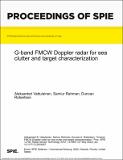Files in this item
G-band FMCW Doppler radar for sea clutter and target characterisation
Item metadata
| dc.contributor.author | Vattulainen, Aleksanteri Benjamin | |
| dc.contributor.author | Rahman, Samiur | |
| dc.contributor.author | Robertson, Duncan A. | |
| dc.contributor.editor | Ranney, Kenneth I. | |
| dc.contributor.editor | Raynal, Ann M. | |
| dc.date.accessioned | 2022-07-07T14:30:14Z | |
| dc.date.available | 2022-07-07T14:30:14Z | |
| dc.date.issued | 2022-05-27 | |
| dc.identifier | 280135164 | |
| dc.identifier | e5e5391d-85bd-4775-9ead-5b6e7d91bfbf | |
| dc.identifier | 85135774395 | |
| dc.identifier | 000850453300028 | |
| dc.identifier.citation | Vattulainen , A B , Rahman , S & Robertson , D A 2022 , G-band FMCW Doppler radar for sea clutter and target characterisation . in K I Ranney & A M Raynal (eds) , Radar Sensor Technology XXVI . , 121080T , Proceedings of SPIE , vol. 12108 , SPIE , SPIE Defense + Commercial Sensing , Orlando , Florida , United States , 3/04/22 . https://doi.org/10.1117/12.2618497 | en |
| dc.identifier.citation | conference | en |
| dc.identifier.isbn | 9781510650923 | |
| dc.identifier.isbn | 9781510650930 | |
| dc.identifier.issn | 0277-786X | |
| dc.identifier.other | ORCID: /0000-0002-4042-2772/work/114641110 | |
| dc.identifier.other | ORCID: /0000-0002-5477-4218/work/114641481 | |
| dc.identifier.other | ORCID: /0000-0003-1898-600X/work/120432947 | |
| dc.identifier.uri | https://hdl.handle.net/10023/25628 | |
| dc.description | Funding: UK Engineering and Physical Sciences Research Council under grant EP/S032851/1. | en |
| dc.description.abstract | Marine autonomy is a field receiving a high degree of interest for its many potential applications in terms of commerce, crew safety, and the military. A successful autonomous vessel depends on a sophisticated degree of situational awareness facilitated by sensors. We are investigating sub-THz radar sensors for this purpose, with the primary goal being the characterization of sea clutter and targets in terms of both amplitude and Doppler statistics at frequencies spanning 24 to 350 GHz, where presently there is a lack of data. Sub-THz frequencies are of particular interest due to improved range and Doppler resolutions, and reduced sensor size, factors expected to be critical in enabling anomaly detection in the dynamic marine environment. As part of this work, a new 207 GHz frequency modulated continuous wave (FMCW) radar is being developed for the collection of clutter and target phenomenology data. The architecture uses a direct digital synthesis (DDS) generated chirp which is upconverted onto a low phase noise microwave LO then frequency multiplied by 24 to the carrier frequency. Twin Gaussian optics lens antennas (GOLAs) are used for transmit and receive with beamwidths of 2° , with adjustable linear polarization. The radar head is gimbal mounted for raster scanning RCS maps or for use in staring mode Doppler measurements. A chirp bandwidth of 4 GHz enables range bins of a few centimeters and high speed chirps enable a maximum unambiguous velocity of ±5 m/s. | |
| dc.format.extent | 9 | |
| dc.format.extent | 6299117 | |
| dc.language.iso | eng | |
| dc.publisher | SPIE | |
| dc.relation.ispartof | Radar Sensor Technology XXVI | en |
| dc.relation.ispartofseries | Proceedings of SPIE | en |
| dc.subject | G-band | en |
| dc.subject | FMCW radar | en |
| dc.subject | Doppler radar | en |
| dc.subject | Radar sea clutter | en |
| dc.subject | Target characterisation | en |
| dc.subject | GC Oceanography | en |
| dc.subject | QC Physics | en |
| dc.subject | U Military Science | en |
| dc.subject | NS | en |
| dc.subject | SDG 14 - Life Below Water | en |
| dc.subject.lcc | GC | en |
| dc.subject.lcc | QC | en |
| dc.subject.lcc | U | en |
| dc.title | G-band FMCW Doppler radar for sea clutter and target characterisation | en |
| dc.type | Conference item | en |
| dc.contributor.sponsor | EPSRC | en |
| dc.contributor.institution | University of St Andrews. School of Physics and Astronomy | en |
| dc.identifier.doi | 10.1117/12.2618497 | |
| dc.identifier.grantnumber | EP/S032851/1 | en |
This item appears in the following Collection(s)
Items in the St Andrews Research Repository are protected by copyright, with all rights reserved, unless otherwise indicated.

